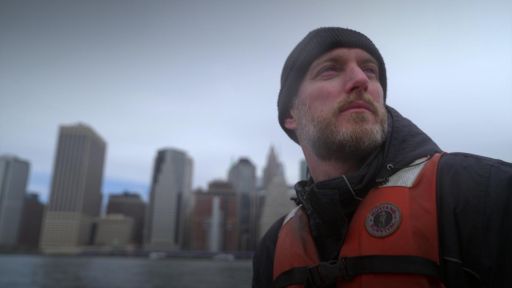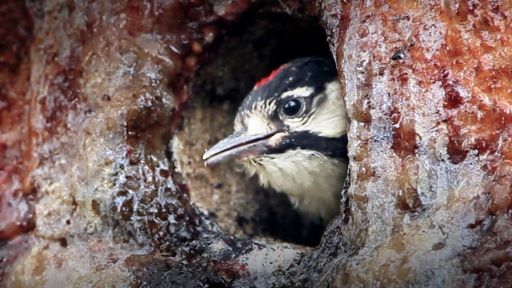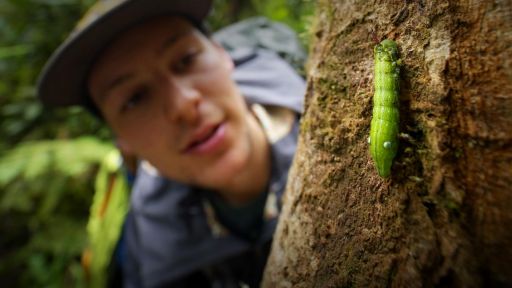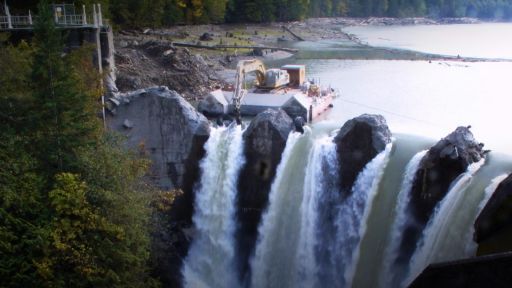TRANSCRIPT
♪ ROISIN: Oh my goodness.
There's one out.
♪ [birds chirping] We know we've been losing our wetlands for centuries now.
♪ [birds chirping] There's no other species like beavers that can really restore these habitats.
♪ The beaver is one of the animals that we really did hunt to extinction in Britain.
♪ I would love to see beavers as a template of what our world could look like in the future but people can get quite upset 'cause they see a beaver as destructive.
It really is about taking people on a journey and about just saying, look, if we want these species back, if we want to tackle climate change and biodiversity crisis we have to look at reintroductions as a conservation tool.
So that's raised the whole question in Britain, are we prepared to live with this species?
♪ ♪ NARRATOR: When we picture the British countryside, we think of vibrant green hills, manicured hedgerows, bubbling brooks and pastoral farmhouses.
♪ But where is the wilderness?
RICH: It often gets called the green and pleasant land and it's very much viewed a bucolic a kind of romanticized way.
But underlying that is radical change that's been put in place by humans to drain pretty well the whole of the UK's landscape for farming.
When we took the water off the land, wilder places, the ecosystems that that landscape did support were also lost.
♪ NARRATOR: Turn back the clock thousands of years and we'd see a very different landscape.
Old growth forests with lynx, wolves and bears... ...and vast wetlands home to creatures with the ability to transform their habitat overnight... ♪ beavers.
♪ RICH: The beaver's been around for millions and millions of years.
We have hunted this animal to near extinction and we've seen ecosystems collapse.
NARRATOR: Beavers are what's known as a keystone species, an organism that helps hold an entire ecosystem together.
Without its keystone, the web of life can unravel.
♪ In Great Britain centuries of farming, hunting and urbanization degraded the landscape and wiped out the beaver.
♪ Some believe that bringing it back will boost biodiversity and build climate resilience.
♪ That idea is being tested in southwest Britain in the county of Devon.
RICH: Just watch your step across the dam there.
[water trickling] NARRATOR: After 400 years without beavers, there was a growing appreciation in the UK for how these wood workers and dam builders might help rewild domesticated landscapes.
RICH: This is the stump of a white poplar tree and you can see all the way across here these beautiful scalloped marks.
It looks like it's been hand carved but actually this is all beaver teeth marks.
Many of the trees that beavers bring down don't actually die.
If you came back here in a year's time you would see dozens of branches sprouting up from here.
Poplar and willow, perhaps hazel as well.
Silver birch, they all respond in this way when they're gnawed.
They bring these big trees down so that they can access the leaves and the nutritious shoots higher up the tree but they also want to take the side branches off and use those for building.
[water trickling] NARRATOR: Beavers are ecosystem engineers.
Because they feel safer in deep water, they've become master architects of dams and pools creating the ideal water level for a beaver lodge.
A multi-chamber home with hidden entrances and a flood resistant design.
RICH: So we're gonna walk across to the main beaver lodge here now which is a pretty impressive structure.
They've built this over the last three and a half, four years.
We have entrance chambers where the beavers could swim under water, pop up inside and there'll be a chamber with a little pond of water where the young kits can learn to swim and then higher up they'll build chambers where they can sleep and eat in the dry.
And when the flood waters in this river system come up high, the beavers have got a place within the lodge that they can escape those flood waters.
Sometimes when you stand very quietly next to a beaver lodge you can hear the beavers snoring and snuffling.
I go to these sites and it feels like going back in time because they're messy and they're chaotic and they're wilder.
♪ NARRATOR: That's a new feeling.
Beavers were long, long gone from England [birds chirping] ♪ and then suddenly, they reappeared.
NEWSCASTER: Now, they're the first breeding population of beavers in the English countryside in hundreds of years.
TOM: This is either a historic day for English conservation or the start of a grave threat to our fragile river ecosystem.
JAKE: Around 2008, some wildlife enthusiasts began to see beavers actually swimming in the river Otter.
NARRATOR: The river Otter.
This 27-mile waterway does have otters but it's best known as the first place in Britain settled by this new generation of beavers.
Whether they escaped from captivity or were released deliberately remains a mystery.
Jake Chant has been keeping an eye on them since they arrived.
JAKE: I think beavers are a very relaxing animal to watch.
If you were to see one swimming past you, you'd see a great big bulky body, dense waterproof fur that keeps it warm in the water.
You'd notice this odd tail that trails along behind it.
Great big webbed rear feet, tiny little ears and it's really not like any other species we've got in England.
Originally the government were quite keen to trap and remove those animals.
But Devon Wildlife Trust, with the support of local communities managed to persuade the government to have a five year trial effectively to assess the impacts that beavers have on lowland England.
We use camera traps a lot to monitor what the beavers are doing.
NARRATOR: With the beavers fate uncertain, the trial aimed to reveal what they were up to and measure their effect on the area.
JAKE: So that's great.
We've got a beaver coming up over the dam really slowly and it's just come down the little track.
You know, they come out about seven o'clock in the evening and they're active through the night.
So this is like a little lens into their world.
NARRATOR: The term "busy as a beaver" is no exaggeration.
As these mammals work tirelessly, damming up streams, felling trees, and building lodges.
During the five years of the trial, the cameras reveal beavers' legendary work ethic and more.
JAKE: We're monitoring the numbers.
So how many kits do you get each year?
We got a lot of activity that we hadn't seen before.
Interactions between species.
♪ It was really interesting to see how otters were using the site that beavers had created.
There's some fantastic camera trap footage of water voles using the canals that beavers have excavated.
So you can see, it's building up the amount of biodiversity in the sheer quantity of life at this site, which is really exciting.
NARRATOR: Species surveys confirmed the camera trap evidence, restoring beavers as a keystone created the right ecological conditions for other native species to return.
♪ In Devon, the trial made a strong case that beavers were beneficial to other wildlife.
But some people wondered if the beavers were benefiting humans as well.
400 miles north in Scotland, Zoologist Roisin Campbell Palmer had already begun answering that question.
ROISIN: I guess I've been lucky cause I get to work up close and personal with this animal so I get a view that maybe many other people don't see of beavers.
Lovely fur.
They're really quite cute.
You know, it's not a word we like to use often but you know, beavers are big, chubby, cute animals and I think that's part of their appeal.
I first began working with beavers about 15 years ago.
I worked at the time for the Zoological Society of Scotland and we did one of the first projects about bringing beavers back.
Part of that was about their ecology and how they fit into landscapes like this again but it was also the social context of are people willing to see this species return?
♪ NARRATOR: Roisin and her team monitored reintroductions closely.
They documented all the good things beavers do but also those that caused concern and conflict.
Altered river courses, felled trees, flooded fields.
They found such risks could be managed and that most people welcomed their new neighbors.
Conservationists in Devon were keen to adapt the Scottish team's methods and asked Roisin to help lead a similar trial here.
But would an approach that worked in rural Scotland have similar success in a more densely populated landscape?
RICH: We hatched upon a plan to run an experiment to see what would happen when these beavers came in and started building dams.
And little did we know what profound change we would observe.
ALAN: Wonder if I just reverse out and then I'll go to that end.
RICH: Can you give us a shove Roisin?
ROISIN: Tell me when you're ready.
RICH: Yeah, that's great.
Go for it.
ALAN: All good?
RICH: Oh, that is great.
If you can hold here, we can get some good measurements.
[water sloshing] Before the beavers built this dam, there was no pond at all on this whole floodplain, but it's completely transformed now.
NARRATOR: Rich has called in hydrologist Alan Puttock to help study how beavers physically alter Britain's rivers.
RICH: 320 there.
NARRATOR: They start by measuring the amount of water the pond can hold.
RICH: Oh yeah, that's probably the deepest so far, 670.
NARRATOR: And how much more it can hold on storms to reduce flooding downstream.
RICH: ...water that's about 700 millimeters deep.
Excellent.
If we get these depths across the whole pond, we can work out what the volume of water is that's being stored and then when the floods come, how much capacity there is to reduce that flooding downstream.
NARRATOR: Over 5 million people in the UK live and work in areas at risk of flooding, costing around one and a half billion dollars in damage a year.
A changing climate only makes matters worse by generating more severe storms with torrential rain.
The village of East Budleigh, situated just west of the river Otter, had suffered from flooding for years but now there's a new beaver dam upstream.
♪ ALAN: So if we set up here.
RICH: Right.
ALAN: So I've been doing these surveys every year for the last four years or so.
It's allowed us to look at the structure of the site and the water storage and how that's changed over time.
ROISIN: Nice.
ALAN: It's starting to take off now.
[drone motor whirrs] ♪ NARRATOR: Satellite and drone images reveal an incredible transformation.
The beavers have turned unused farmland into wetland.
♪ ROISIN: The pond's massive.
ALAN: So it was really restricted to just around where the original channel was ROISIN: Mm-hmm ALAN: But now it's kind of spread out.
What do you reckon, 50, 60 meters?
ROISIN: Wow.
♪ NARRATOR: This new wetland changes the way water flows downstream during storms.
ALAN: There we go.
We can already see.
NARRATOR: Without the beaver dam, storms overfill the river and cause flooding.
Lucky for this village, the dam slows and redirects water through braided streams and wetlands that hold more water than a straight and unimpeded channel.
Since the beavers built their dam about four years ago East Budleigh hasn't experienced a single flood.
ALAN: Storm flows have been reduced by up to 50%.
NARRATOR: And during the hottest months of the year, while adjacent land has dried up and turned yellow, the beaver built wetlands remain lush and green.
RICH: It stays there all year round, even in the driest times of year, the drought periods we've still got a huge beaver pond here.
♪ NARRATOR: But these benefits have some trade-offs.
Beavers can also divert water in ways that make some neighbors unhappy.
♪ ADRIAN: Beavers are ingenious animals, although I'd rather their ingeniousness was not done here.
[laughs] And we've had dams, I'm six foot and I've had them way above my head.
And the only way we can get them out is with a digger and I have to pay for that expense.
[water trickles] NARRATOR: Beaver's activities can radiate out from the riverbank, threatening farmland and homes.
MARTIN: They're recognized as being a biodiversity benefit, and in some areas that's absolutely the case.
There's no doubt about that.
However, where they are causing serious agricultural damage we need to be able to control them.
NARRATOR: When livelihoods are at stake, some opponents in the UK have even resorted to culling.
But when tensions flare here in Devon, there are folks committed to keeping the peace.
ED: We manage two and a half thousand acres alone in heathland and on top of that I do beaver work.
NARRATOR: Ed Lagdon is a ranger at one of the largest estates in Devon.
He's heading out to a beaver dam that's causing flooding at one of many farms on the property.
He and Matt Holden of the Devon Wildlife Trust respond to calls like this daily.
MATT: So how long have you been managing this one for?
ED: This dam's been here for about, off and on about two years.
It's really nice habitat, but unfortunately it's started to impact a local farmer's gateway.
So this one is gonna have to be lowered slightly.
MATT: Yeah.
Yeah.
ED: Beavers can work really quickly.
So within a few nights this came up to this level.
MATT: It's amazing how they weave the sticks in though.
They're properly creative.
ED: They're really good construction workers.
MATT: Yeah, yeah, yeah.
NARRATOR: Simply lowering a beaver dam lowers water level and mitigates local flooding.
ED: Beavers need management.
We want landowners and tenants for sure to support beavers but when they see crops destroyed and no action is where people start having issues.
MATT: Yeah.
Yeah.
ED: So as long as we can react quickly, we should all be happy.
MATT: Yeah.
I think the key thing we are kind of learning, isn't it, that you always need someone who you can call.
ED: Yeah.
MATT: And get support from them.
ED: Yeah.
NARRATOR: Matt and Ed have learned that a quick response can quell frustrations and safeguard property.
But when a dam is built upstream from a house, lowering its level may not be enough.
MATT: This one is actually pretty deep.
ROISIN: Oh Wow.
MATT: So I hope you're ready for that.
ROISIN: Watch.
You're taller than me.
[both laughing] If you're a house owner, you don't want, you know water pouring down the side of your house.
We don't wanna drain this pond but we want to reduce the height.
By putting a pipe through a dam we can regulate the water level behind it.
So it's not about removing that dam, it's just about compromising the height of the water to keep a landowner's house from a flood risk.
NARRATOR: A simple drain pipe serves as a highly effective flow device and it has this beaver family baffled.
[beavers chittering] ROISIN: You know, the first night we put it in and the beavers come back and you can literally see their brains going what the F is this?
And they're like, no, just no.
[laughs] ♪ MATT: We're just setting that level where we want it to be and where we feel the beavers can tolerate it as well.
ROISIN: And, well, it's working, isn't it?
MATT: Yeah.
ROISIN: The beavers are here and you've changed the flow of water back into this channel and it's definitely handling your water... MATT: Yeah, yeah.
ROISIN: ...issue right now.
And obviously flooding of the house.
NARRATOR: Hands-on management reduces public concern but there's still a lot of misinformation about beavers that gets folks riled up.
Like myths that they eat fish and diminish fish stocks.
When in reality they only eat plants.
♪ Others worry they fell too many trees.
♪ CHRIS: Lamby, lamby, lamby.
[lambs bleating] Come on lamby, lamb.
[lambs bleating] NARRATOR: Farmer Chris Jones has embraced beavers on his land and is helping the public see the positives.
CHRIS: You stay here.
You'll stay here and look after the beavers.
NARRATOR: Jones initially became interested in beavers' ability to increase drought resistance.
CHRIS: The land gets completely dried out very, very quickly and we're seeing it all over the world, frankly.
So we have to learn to live much much more in tune with nature.
NARRATOR: Fearing for his farm, he got a permit to introduce a family of beavers.
CHRIS: The beavers have been back here for five years.
You know, we're in drought conditions now really and it's still holding lots and lots of water.
We had water we could pump out onto fields and that was really quite something.
NARRATOR: He also chronicled a biodiversity boon.
[water trickling] ♪ CHRIS: When we take a normal stream, you could sense like a little bonfire of biodiversity and we put the beavers into that system and it's like throwing gasoline onto that fire.
And so now five years in, we've had 10 different new bird records here.
We regularly record 11 different bat species here.
We've had new mammal species turn up.
The fish have doubled in size.
NARRATOR: Once he saw the beavers impact firsthand, Chris became the community and land director for the Beaver Trust, dedicating part of his property to educating the public about the benefits of beavers.
[insects chirping] One such visitor is biologist Sacha Dench.
CHRIS: Hi Sacha, how are you?
SACHA: Hello.
Can we have a look?
CHRIS: Yeah, let's come head on down the track.
NARRATOR: She's a swan fanatic, but her love of the majestic waterfowl has given her a new appreciation for beavers as well.
Sacha became the first woman to cross the English channel by paramotor in order to follow swans during migration.
SACHA: Having flown from the Russian Arctic to the UK following swans on migrations, realizing that actually if there were a prime habitat for swans or nesting habitat for swans would have been beaver lodges.
NARRATOR: Sacha's a vocal advocate for how reintroducing beavers can create waystations for migratory birds.
SACHA: The cost to man make a wetland when you need to recreate it is vast.
The cost of bringing in a few beavers to do the same job is tiny.
CHRIS: Yeah, yeah.
SACHA: And it is just a much more sensible way of... CHRIS: Yeah.
Totally.
SACHA: ...bringing back all the wetlands we've lost.
NARRATOR: In the summer of 2021, Sacha attempted the first paramotor circumnavigation of mainland Britain to raise awareness about climate change.
But a mid-air collision left her seriously injured.
Chris and his volunteers at the Cornwall Beaver Project recently completed the world's first wheelchair accessible beaver boardwalk and now Sacha is taking it for a test drive.
SACHA: It definitely made a big difference for me having been in hospital for five and a half months.
Having something like this to look forward to, well it's all really important for your general wellbeing.
In an ideal world, you'd like people to be much more open to slightly wilder landscapes because we'll be fixing so many of the biodiversity issues that we try to do with little bandaid solutions.
Actually, we need to let a little bit more wild, a little bit more chaos in the landscape.
CHRIS: I would concur.
We need to let a little bit more chaos in.
It will just provide the most incredible opportunities for nature recovery networks.
Why shouldn't we be ambitious about this?
This animal can live amongst us and we can learn to live with it.
NARRATOR: Britain's beavers are making a strong case that the island nation is better off with them than without them.
[water trickling] JAKE: You have a species being brought back that actually has the ability as a keystone species to create habitats for many other species.
[birds chirping] [water trickling] RICH: Every time I visit a beaver landscape, dams have been built, trees have been felled and worked into structures.
Canals have been cut onto floodplains.
That really gives me hope because I can see a vision of the future which is almost a mirror of the past.
NARRATOR: Wherever there are beavers, biodiversity is returning and their aquatic engineering may offset extremes brought on by climate change.
ROISIN: The cool thing about beavers is they can change landscapes if we let them.
Just having communities that are more robust to change whether that's drought or flooding, making sure that we can deal with the climatic changes that are coming.
So to me it's a wider social question.
Are we prepared to let our rivers have a bit more space?
Are we prepared to see wetlands be restored?
♪ NARRATOR: More and more people in Britain are glad to see beavers reclaim their former habitat.
♪ In July of 2022, the UK government enacted new protections for beavers and recognized them as a native species.
♪ ROISIN: What I'm really hopeful is actually the speed of change and now it's a national discussion point.
The government are actually discussing how are we going to support wild releases?
That's major.
NARRATOR: This animal's legacy stretches far beyond the rivers they command.
Beavers are offering th e nation a chance to rediscover its relationship with the wild.
♪







